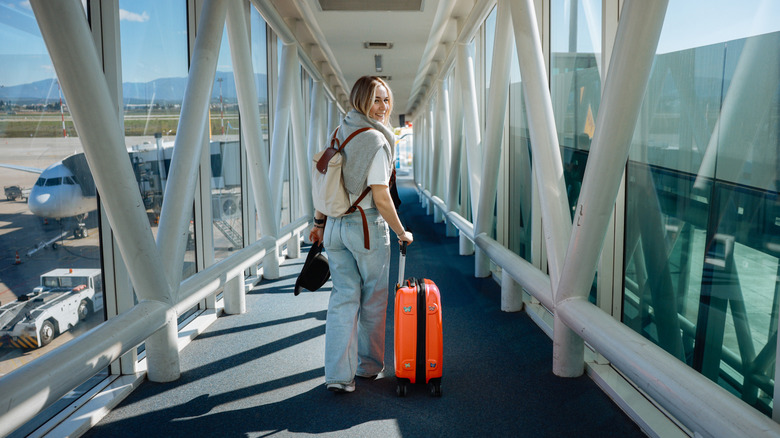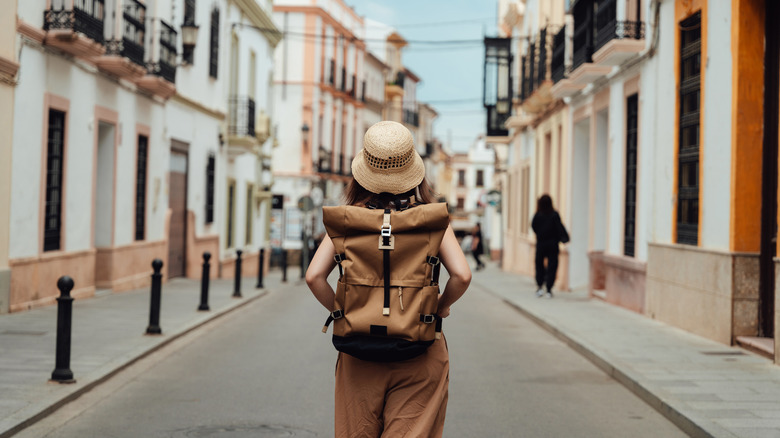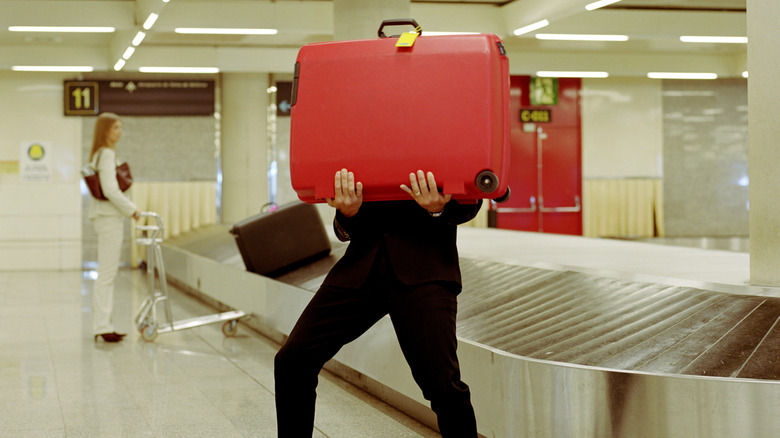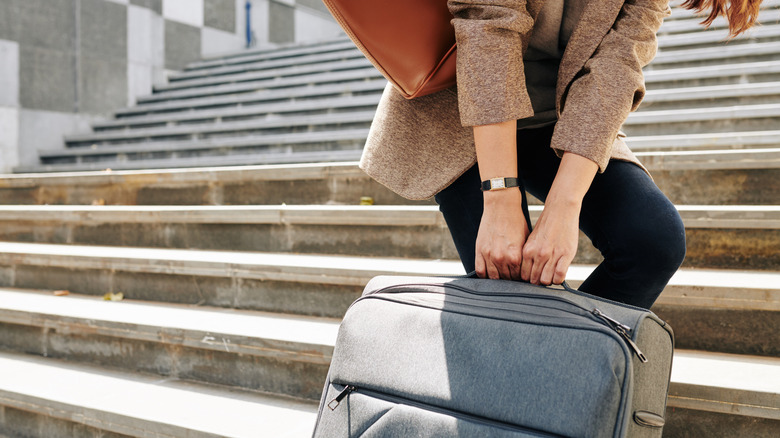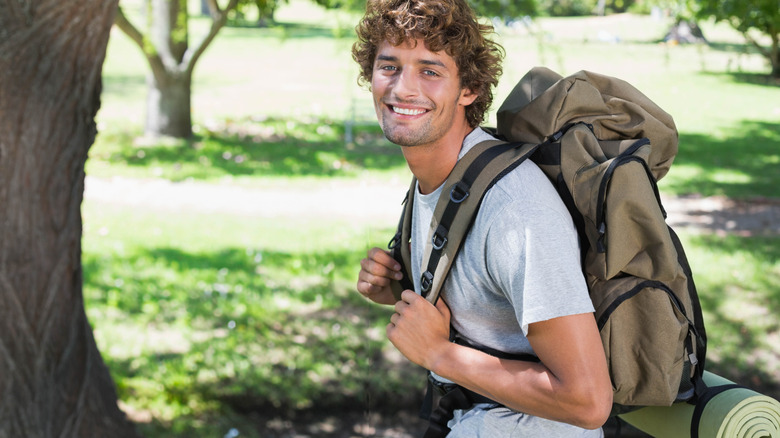Rick Steves' Secrets To Choosing The Best Luggage For International Trips
If you're heading out on an international trip, you may be considering purchasing some new luggage. That said, there are a lot of options out there — including the possibility of buying a too-large bag that you'll likely be forced to check. Worse yet, in addition to paying high checked-baggage fees, that also means having to drag it all through airports, on trains, and down streets. However, if you've listened to travel pro Rick Steves' advice in the past, you already know that he's a strong advocate for packing only a carry-on — even for a long trip overseas.
Sure, that sounds great, and it certainly makes moving around easier while you vacation. However, how do you know which bag to pick? Luckily, Steves has come to the rescue once again, providing some great advice on the best bag to choose, the dimensions and weight that will work best, what stands out in terms of packability, and, most importantly, which type will be most comfortable.
On his website, Steves writes: "A fundamental packing question is your choice of luggage," and he's not kidding. A great-looking bag that seems perfect may not fit as a carry-on for certain European airlines. Meanwhile, a sleek design might stand out on the shelf, but it can also be really uncomfortable to carry around for hours. Ultimately, if anyone can tell you the right things to look for in a bag, it's Rick Steves. So much so that he's even designed a carry-on suitcase of his own.
The best type of bags, according to Rick Steves
Steves has a few bag styles that he recommends. However, first, he wants us to ask ourselves: "Is it small enough to work as a carry-on?" While a large suitcase might not be an issue if you plan on staying in one hotel for your entire trip, if you're moving around, it's important to consider other options. For example, Steves explains that he'd only consider "a carry-on-size soft backpack, an internal-frame backpack, a carry-on-size bag with wheels, or a carry-on-size rolling backpack."
You'll notice that three of those are backpacks — and, depending on the type of trip you're on, they may work best for you. For example, a carry-on-size backpack is great for minimalists who overpack. And while you may have a hard time keeping things unwrinkled, a smaller backpack is perfect if you're traveling between cities or hiking. Plus, they're also great because they can squish under and into anything, leaving your hands free.
Meanwhile, an internal frame backpack will give you more stability, but it adds bulk and may not work as a carry-on. However, a lightweight frame is good for keeping weight distributed across the whole bag rather than settling into the bottom. A hybrid bag that can be used as both a backpack and a rolling bag is another option that allows you to switch where the weight is on your body, but wheels and straps take up valuable packing space. Finally, a rolling-carry-on bag is a good option for most people that keeps weight off your shoulders, though they may be more expensive.
Finding the right dimensions and wheel options
According to Steves, the dimensions of the bag you choose matter more than you might think. While most U.S. airlines allow a standard carry-on size, some European airlines have smaller acceptable dimensions for what you're allowed to bring. In the same vein, Steves also mentions budget airlines like Ryanair, and says you may actually want to consider paying for a carry-on (which you'll have to do unless you have a priority ticket).
With that in mind, Steves agrees that, although a wheeled bag can be a great option, you sacrifice a bit of space for the wheel beds. As for choosing how many wheels you want, he writes: "Four-wheeled 'spinner' suitcases are the easiest to move along even ground — pushing one along takes less work than pulling a two-wheeled bag, which doesn't roll unless you're bearing some of its weight." However, he also argues that spinners can become an issue when you're dealing with cobblestones and uneven surfaces. And, if you're not careful, they can roll away from you.
Wheels aside, Steves also recommends that you make sure it's light enough for you, since you'll still have to lift it here and there. That means you should look into good clothes-rolling techniques — like the ranger roll — so you can fit more things into a smaller space. Whatever you choose, it's worth testing your technique before the day of your trip to make sure it actually works for you and your travel style.
Take weight into consideration
Weight can be a big issue with luggage before you pack a single item. Again, even if you're rolling a bag along, you're still going to have to lift it into the overhead bin on a plane, carry it up and down stairs, and pull it over bumps and curbs. That said, if you prefer backpacks, you should look into packing as light as possible. After all, carrying and lifting heavy things can cause issues with your back — and the last thing you want on vacation is to end up in a doctor's office. Sure, the spirit may be willing, but you have to make sure your body can carry weight this way for hours at a time.
It's also important to remember that bags themselves have weight to them before you even pack. As a general rule, Steves prefers to keep any empty bag he uses around 7 pounds. In addition, he also writes that a soft backpack will be the lightest of all the choices, with an internal frame backpack being slightly heavier, a rolling backpack on the medium side for the most part, and a rolling bag the heaviest. To ensure you're comfortable with your choice, you may want to take some time with the bag you choose, carrying it around for a full day before you get on a plane with it.
As for staying within weight restrictions, there are several packing tips that can help you avoid tipping over the limit. This includes wearing your heaviest garments and shoes on the plane to keep your bag even lighter, and packing a capsule travel wardrobe you can mix and match throughout your trip.
Hard vs. soft cases
Ask any group of travelers about their thoughts on hard versus soft luggage and you'll likely get a variety of answers. Steves himself writes: "In general, I prefer a soft-sided suitcase. Hard-sided bags tend to be expensive, and even the ultra-light models are still a pound or two heavier than most soft-sided bags. Their major advantage is the protection they offer any breakables you're hauling home." In addition, soft-sided cases can also give you a bit more leeway in terms of over-packing, as they may stretch a bit. Plus, Steves also reminds readers that you can still wrap anything fragile against damage in a soft-sided suitcase, so safety shouldn't be an issue. In contrast, hard-side suitcases offer a finite amount of space, so overstuffing it and then sitting on top of it to get it zipped isn't likely to help much. Staying true to his word, the Riga Rolling Case that he designed and sells on his website is a hybrid style rolling bag that has hard edges, but soft pockets on the outside.
Ultimately, if you're choosing between hard and soft suitcases for yourself, pay close attention to what they're made of. Soft suitcases are usually made of nylon. If you're looking for a good sturdy one, consider cordura nylon, which is abrasion-resistant. You'll also want to look for thicker fabrics; that way, it's less likely to be punctured or ripped. On the other hand, hard suitcases are often ABS and polycarbonate plastic, or aluminum. The latter is likely to last the longest, but it may be heavier. However, it's likely going to give you the most protection if you're bringing home something like ceramics or glass.
More tips for purchasing the right bag for your trip
Choosing the right bag is all about personal preference. If you're taking a week-long hike, a framed backpack for support may be your best bet. If you're purchasing fragile items, a hard-backed rolling bag may be what you're looking for. Comfort is also important, so you'll want to look at what sort of handles and flaps a bag has for when you do have to lift it. If you're taking a backpack, look into padded straps, as well as a waist and chest strap to help take some of the weight off your shoulders.
Wheel material also matters, whether you're rolling a hybrid backpack or traditional rolling bag. Frail or thin plastic ones likely won't survive a day on cobblestones; meanwhile, thicker rubber wheels may give you the bounce you need. Steves also mentions looking at packing cubes, which help keep your items separate inside your bag. These can be a lifesaver if you're using a backpack and don't want to rummage through everything to find a specific item.
In addition, look at what sort of closures a bag has. Do the zipper pulls lock together, or should you get a TSA-approved lock to secure it? If you're carrying a backpack, are there open pouches that you can't secure, making them targets for pickpockets? Beyond security, you may also want to skip a black bag and pick a bright color so it's easier to recognize. Finally, Steves isn't completely Spartan in his packing mindset. He suggests sacrificing some luggage space to pack your guilty pleasure. For him, it's noise-canceling headphones, and for fellow travel expert Samantha Brown, it's a tea cup and collapsible kettle to enjoy her non-negotiable morning ritual from the road.
